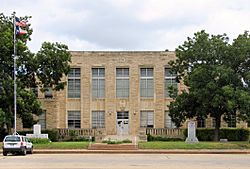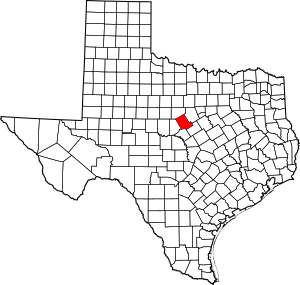Comanche County, Texas facts for kids
Quick facts for kids
Comanche County
|
|
|---|---|

The Comanche County Courthouse in Comanche
|
|

Location within the U.S. state of Texas
|
|
 Texas's location within the U.S. |
|
| Country | |
| State | |
| Founded | 1856 |
| Named for | Comanche tribe |
| Seat | Comanche |
| Largest city | Comanche |
| Area | |
| • Total | 948 sq mi (2,460 km2) |
| • Land | 938 sq mi (2,430 km2) |
| • Water | 9.9 sq mi (26 km2) 1.0% |
| Population
(2020)
|
|
| • Total | 13,594 |
| • Density | 14.340/sq mi (5.5366/km2) |
| Time zone | UTC−6 (Central) |
| • Summer (DST) | UTC−5 (CDT) |
| Congressional district | 25th |
Comanche County is a county located on the Edwards Plateau in Central Texas. As of the 2020 census, its population was 13,594. The county seat is Comanche. The county was founded in 1856 and is named for the Comanche Native American tribe.
Contents
History
- Among the first inhabitants were the Comanche Indian tribe.
- In 1854, Jesse M Mercer and others organized a colony near the future settlement of Newburg in Comanche County on lands earlier granted by Mexico to Stephen F. Austin and Samuel May Williams. Frank M. Collier built the first log house in the county.
- In 1856, the Texas legislature formed Comanche County from Coryell and Bosque counties. Cora community, named after Cora Beeman of Bell County, was designated as the county seat.
- Comanche became the county seat in 1859.
- As of 1860, the county population was 709 persons, including 61 slaves.
- The Comanche Chief began publication in 1873. Editor Joe Hill’s brother, Robert T. Hill, worked on the newspaper while developing his esteemed career as a geologist.
- John Wesley Hardin and his gang celebrated his 21st birthday in 1874 in Brown and Comanche counties. Deputy Charles Webb drew his gun, provoking a gunfight that ended Webb’s life. A lynch mob was formed, but Hardin and his family were put into protective custody. The mob broke into the jail and hanged his brother Joe and two cousins. Hardin fled.
- In 1877, John Wesley Hardin was arrested on a train in Pensacola, Florida by Texas Rangers and a local authority while traveling under the alias James W. Swain. Hardin was tried in Comanche for the murder of Deputy Sheriff Charles Webb, and sentenced to 25 years in Huntsville Prison.
- The Texas Central Railroad began service in Comanche County in 1885, and began carrying cattle and cotton to market.
- By 1890, cotton had become king in the county, but by the start of the 20th century, the boll weevil had devastated the county cotton industry for three decades.
- In 1907, farmers in the county began to experiment with peanut farming.
- Oil was discovered at Desdemona in 1910.
- The peak year for the Comanche County oil boom was 1920. More than 70,000 fruit trees were grown in the county.
- In 1951–1952, a desperate, drought-stricken county experimented with rain making.
- Proctor Lake was impounded in 1963 to provide flood control and drinking water.
- From 1968 to 1974, the Comanche County native Jim Reese served as the mayor of Odessa, Texas. He launched unsuccessful congressional campaigns in the 1976 general election against the Democrat George H. Mahon and in the 1978 Republican primary against George W. Bush.
- During the 1970s, the oil industrialist Bill Noël of Odessa purchased orchards in Comanche County.
- As of 1982, Comanche was ranked second in Texas, with a peanut production of more than 45,546,000 pounds.
Geography
According to the U.S. Census Bureau, the county has a total area of 948 square miles (2,460 km2), of which 938 square miles (2,430 km2) is land and 9.9 square miles (26 km2) (1.0%) is water. The county is located some sixty miles north of the geographic center of Texas.
The county is home to Proctor Lake.
Adjacent counties
- Erath County (northeast)
- Hamilton County (southeast)
- Mills County (south)
- Brown County (southwest)
- Eastland County (northwest)
Demographics
| Historical population | |||
|---|---|---|---|
| Census | Pop. | %± | |
| 1860 | 709 | — | |
| 1870 | 1,001 | 41.2% | |
| 1880 | 8,608 | 759.9% | |
| 1890 | 15,608 | 81.3% | |
| 1900 | 23,009 | 47.4% | |
| 1910 | 27,186 | 18.2% | |
| 1920 | 25,748 | −5.3% | |
| 1930 | 18,430 | −28.4% | |
| 1940 | 19,245 | 4.4% | |
| 1950 | 15,516 | −19.4% | |
| 1960 | 11,865 | −23.5% | |
| 1970 | 11,898 | 0.3% | |
| 1980 | 12,617 | 6.0% | |
| 1990 | 13,381 | 6.1% | |
| 2000 | 14,026 | 4.8% | |
| 2010 | 13,974 | −0.4% | |
| 2020 | 13,594 | −2.7% | |
| U.S. Decennial Census 1850–2010 2010 2020 |
|||
| Race / Ethnicity (NH = Non-Hispanic) | Pop 2000 | Pop 2010 | Pop 2020 | % 2000 | % 2010 | % 2020 |
|---|---|---|---|---|---|---|
| White alone (NH) | 10,846 | 10,145 | 9,197 | 77.33% | 72.60% | 67.65% |
| Black or African American alone (NH) | 62 | 25 | 39 | 0.44% | 0.18% | 0.29% |
| Native American or Alaska Native alone (NH) | 52 | 47 | 49 | 0.37% | 0.34% | 0.36% |
| Asian alone (NH) | 17 | 34 | 38 | 0.12% | 0.24% | 0.28% |
| Pacific Islander alone (NH) | 1 | 4 | 3 | 0.01% | 0.03% | 0.02% |
| Other Race alone (NH) | 3 | 8 | 24 | 0.02% | 0.06% | 0.18% |
| Mixed race or Multiracial (NH) | 117 | 106 | 377 | 0.83% | 0.76% | 2.77% |
| Hispanic or Latino (any race) | 2,928 | 3,605 | 3,867 | 20.88% | 25.80% | 28.45% |
| Total | 14,026 | 13,974 | 13,594 | 100.00% | 100.00% | 100.00% |
As of the census of 2000, 14,026 people, 5,522 households, and 3,926 families were residing in the county. The population density was 15 people per square mile (5.8 people/km2). The 7,105 housing units had an average density of 8 per square mile (3.1/km2). The racial makeup of the county was 87.30% White, 0.44% African American, 0.61% Native American, 0.13% Asian, 9.71% from other races, and 1.82% from two or more races. About 21% of the population were Hispanics or Latinos of any race.
Of the 5,522 households, 29.8% had children under 18 living with them, 59.2% were married couples living together, 8.1% had a female householder with no husband present, and 28.9% were not families. About 26% of all households were made up of individuals, and 15.2% had someone living alone who was 65 or older. The average household size was 2.48, and the average family size was 2.98.
In the county, the age distribution was 25.3% under 18, 7.1% from 18 to 24, 23.3% from 25 to 44, 24.0% from 45 to 64, and 20.3% who were 65 or older. The median age was 40 years. For every 100 females, there were 95.8 males. For every 100 females 18 and over, there were 94.4 males.
The median income for a household in the county was $28,422, and for a family was $34,810. Males had a median income of $26,094 versus $18,912 for females. The per capita income for the county was $14,677. About 14% of families and 17.30% of the population were below the poverty line, including 22.6% of those under 18 and 16.0% of those 65 or over.
Transportation
Major highways
Airport
The Comanche County-City Airport is located 2.0 nautical miles (2.3 mi; 3.7 km) northeast of the City of Comanche's central business district.
Media
Comanche County is currently listed as part of the Dallas-Fort Worth DMA. Local media outlets include KDFW-TV, KXAS-TV, WFAA-TV, KTVT-TV, KERA-TV, KTXA-TV, KDFI-TV, KDAF-TV, and KFWD-TV. Other nearby stations that provide coverage for Comanche County include KCEN-TV, KWTX-TV, and KAKW-DT from the Waco/Temple/Killeen DMA, and KTXS-TV, KTAB-TV, and KRBC-TV from the Abilene/Sweetwater/Brownwood DMA.
Two local newspapers serve Comanche County: the Comanche Chief and the De Leon Free Press.
Communities
Cities
Town
Unincorporated communities
Ghost Towns
- Cora
- Mercer's Gap
- Suez
- Comanche County from the Handbook of Texas Online
 |
Eastland County | Erath County |  |
|
| Brown County | Mills County | Hamilton County |
Education
School districts include:
- Blanket Independent School District
- Comanche Independent School District
- De Leon Independent School District
- Dublin Independent School District
- Gorman Independent School District
- Gustine Independent School District
- Hamilton Independent School District
- Hico Independent School District
- Lingleville Independent School District
- May Independent School District
- Mullin Independent School District
- Priddy Independent School District
- Rising Star Independent School District
- Sidney Independent School District
- Zephyr Independent School District
It is in the Ranger College district according to the Texas Education Code.
See also
 In Spanish: Condado de Comanche (Texas) para niños
In Spanish: Condado de Comanche (Texas) para niños

